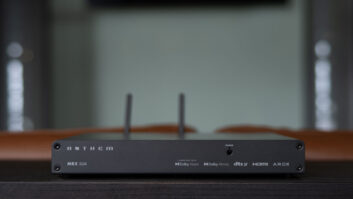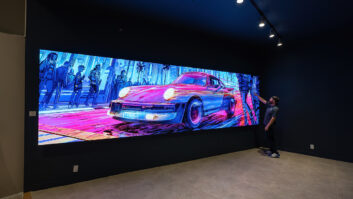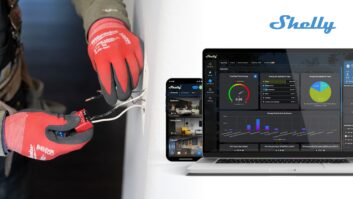My mom used to be fond of telling the story about the first new TV our family bought after I was born. I was probably seven or so, and already had a knack for taking apart things that oughtn’t be taken apart. So to the surprise of exactly no one—except for perhaps the guy who delivered our new 25-inch Zenith — by the time he finished filling out the delivery receipt for my parents, I had the back of the new set removed, and exclaimed with utter exasperation, “We’re being ripped off! This TV is missing all its vacuum tubes!”
Granted, I’ve learned a lot about solid-state circuitry since, but that little tinkerer still lives within me, so when Anthem announced a 3D Upgrade Kit for its D2v and AVM 50v AV processors, I knew I wanted one for my own D2v. Not that I really care about 3D, mind you; I suffer through the occasional clip when a review calls for it, or to find eye-popping demo material, but I view it more as taking a bullet for the team than an actually enjoyable endeavor. It wasn’t so much that I wanted the 3D upgrade, but I wanted to perform the 3D upgrade, not only to satiate my inner tinkerer, but also as part of my never-ending quest to be as custom installer-y as I possibly can.
There’s that, and there’s also the fact that the Anthem 3D upgrade kit is a bit of an anomaly in the high-end AV market. Outside of truly modular offerings—like NAD’s M15 HD2—you’re usually stuck with what you bought when it comes to ultra-high-end home theater gear, and for a nearly four-year-old AV processor like that D2v, that means no 3D. And make no mistake about it, the D2v isn’t a modular device. Look at its chassis, and it appears to be an impenetrable tank. Which, for the tinkerer in me, made the upgrade process all the more tantalizing.
Of course, as is my lot in life, the upgrade processes was also complicated for me by the fact that I have one of the earliest D2vs, which aren’t eligible for the simple mezzanine board replacement for units manufactured later. Still, I wanted to give you guys a glimpse at the upgrade process, in case you have any old D2vs in the field that haven’t been upgraded yet.
The image below is of the interior of my D2v. The two little boards highlighted in green are the mezzanine boards that need replacing in later models, with a single new mezzanine board that covers all the same inputs and outputs. Other than some rearranging of the ribbon cables, that’s pretty much it.

In my case, though—and in the case of all original D2vs—the bigger, main video board beneath the mezzanine boards need to be replaced, too. As you can see below, the D2v sans video board and mezzanine boards is a little scary, with ribbon cables and connectors hanging loose. But if you’re performing your first upgrade soon, don’t fret about that too much. A quick look at the images in the instruction manual provided by Anthem leave no question as to where the cables should be connected. Unfortunately, said manual doesn’t address all of the particulars of how to replace the main video board (it’s geared toward mezzanine-only replacements), but it really isn’t hard to figure out. I honestly spent more time removing the screws and taking off the D2v’s cover than I did pulling out the old boards.

The only thing I wish the instructions had addressed a little more clearly is the S-Video bracket, highlighted below in aqua-blue. It quickly becomes obvious that removing it is necessary for the removal of the main video board, and getting it off wasn’t too hard, but getting it put back on was nearly impossible with my big Wookiee paws. I ended up having to use tweezers to hold the nuts in place while carefully threading the screws in from the back of the processor.

Below is what the completed upgrade looks like, but we still need to touch upon replacing the cables I removed. If you’re just doing the mezzanine upgrade, this step is actually a little trickier than it is if you’re placing the full video board. In an original, pre-3D D2v, the cable that starts at the port labeled 2 below, originally connected to port 1. You’ll have to put a kink in it and attach it to port 3 then run a new cable from port 4 to port 1. If you’re doing the full video board and mezzanine board replacement, ports 2 and 3 come pre-connected, and you merely need to connect the cable from port 4 to port 1, then re-attach the connections for ports 5 and 6. It’s easier than it sounds.

With that done, you’re almost ready to put the cover back on, upgrade the firmware, and boot the D2v back up for testing. But, there is one other cable you want to pay attention to. This tricky little curly guy over on the edge is going to get pushed around quite a bit during the board replacement process:

You can’t quite see it in the image here, but there’s a little groove into which that cable is supposed to fit. If you don’t seat it back into that groove, it’s going to get squished between that little vertical circuit board and the top of your D2v’s case when you screw it back on. Not good.
As you can see below, though, once the upgrade is done—assuming you tightened all of your screws correctly and didn’t squish that curly cable—the finished, upgrade D2v looks factory fresh; it doesn’t look modified in the slightest. Anthem also provides a little 3D sticker for you to put on the back to indicate that the D2v is now a fully 3D capable model, so there’s no mistaking it. The package handily includes the torx #10 and robertson #0 bits you’ll need to remove and replace all of the various screws inside and outside the D2v, as well as a handy grounding strap that you stick to the inside of the chassis and wrap around your arm, to make sure nothing goes “zap” during the upgrade process.

Honestly, the trickiest part of the entire upgrade process for me was labeling all of my interconnects, digging the D2v out of my rack, and re-installing it once everything was done. The upgrade process itself took about half an hour, tops. On a scale from 1 to No Freaking Way, I’d peg the difficulty level of the entire upgrade process as falling somewhere between replacing the video card in your PC and swapping out its processor and heat sink.
What’s most interesting for me, though, is the fact that although I embarked on this upgrade process for the sheer academic pleasure of doing it, I’m loving my new 3D-capable Anthem D2v. The first four HDMI inputs now switch so much faster (so, so much faster), and not only that, but it’s allowed me to simplify the cabling behind my rack, routing my OPPO Blu-ray player’s HDMI output entirely through the D2v, rather than splitting the audio and video signals and running the latter directly to my display, which my Control4 system appreciates very much. So the upgrade ended up being not entirely academic after all.
Retail pricing for the two available 3D Upgrade Kit for the Anthem D2v and AVM 50v are $1,500 for units with serial numbers before 142626, like mine, which require the full video board replacement; and $500 for all serial numbers after, which only require the mezzanine board replacement.







